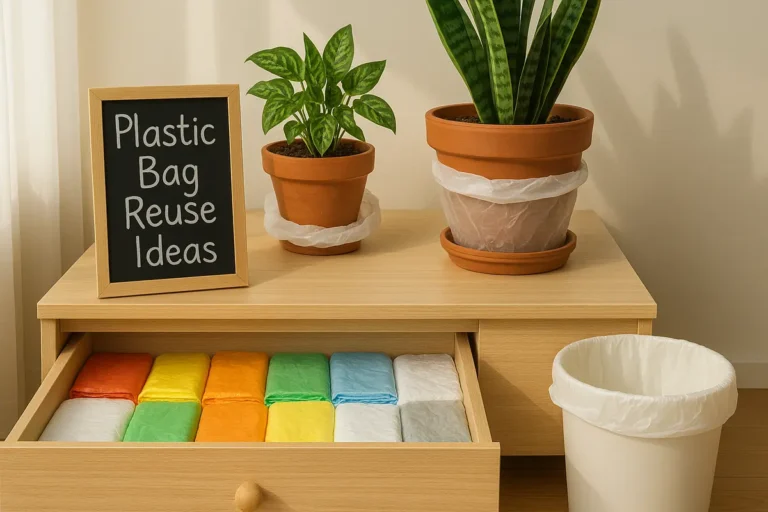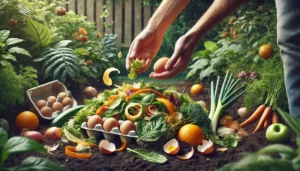We all have that one spot at home—a drawer or cupboard overflowing with plastic bags from grocery stores, deliveries, and shopping trips. For many of us stepping into the world of sustainability, this growing pile might feel frustrating. While tossing them seems the easiest option, reusing them is a much more sustainable option.
Fortunately, these plastic bags don’t have to go in the trash. With some creativity, you can turn them into something useful.
This guide will show you how to reuse plastic bags at home. From lining trash bins to crafting and organizing, these ideas are simple, beginner-friendly, and easy to try.
So, if you’re ready to start your journey towards plastic bag reuse, let’s dive in.
Practical Plastic Bag Reuse Ideas to Try at Home
Organize and Store Using Plastic Bags
Plastic bags are more useful than they seem. They’re flexible, water-resistant (to some extent), and easy to store. These simple qualities make them great tools for organizing your home.
1. Lining Small Waste Bins: This is the most common and practical way to use plastic bags. You can use it as a bin liner for small trash cans in bathrooms, bedrooms, or offices.
2. Protecting Delicate Items During Storage or Moving: Reuse plastic bags to store seasonal decorations, fragile ornaments, or delicate clothing. They help prevent scratches and dust. Plastic bags can also act as protective cushioning.
3. Organizing Drawers and Cabinets: Use smaller plastic bags to organize loose items. Sort small items such as cords, toys, or craft supplies into separate bags and label each one. It prevents things from cluttering and makes it easier to find what you need. In the kitchen, they can organize cleaning cloths, sponges, or small utensils within cabinets.
4. Separating Items in Luggage: While traveling, use plastic bags to separate clean clothes from dirty laundry or to keep shoes and wet swimwear from other items. It helps keep things tidy and prevents dirt and odors from spreading within the suitcase.
5. Storing Craft Supplies: If you enjoy crafting, you probably have lots of small items like yarn scraps, beads, buttons, or paint tubes. You can use plastic bags to organize similar supplies together. It helps keep everything tidy and prevents materials from getting lost.
6. Containing Pet Waste: For pet owners, instead of buying poop scoopers, using plastic bags can be a practical and environmentally conscious choice. It gives the bags a second life before their final disposal.
Creative Crafting and DIY Adventures
Beyond simple storage, here are a few creative ideas to transform old bags into something beautiful and useful.
7. Plastic Bag Yarn (Plarn) for Knitting and Crochet: Cutting the grocery bags into strips and looping them together turns them into plastic yarn, also called plarn. This upcycled material is strong and flexible and is used to make tote bags, doormats, coasters, or outdoor furniture coverings. You can find video tutorials online to guide you through the process.
8. Woven or Braided Mats and Rugs: By cutting plastic bags into strips and weaving them together, you can create durable and waterproof mats for entryways, bathrooms, or outdoor use. Use plastic bags of different colors to create interesting patterns and designs.
9. Eco-Friendly Gift Wraps: Use colorful and patterned plastic bags to wrap small presents. It shows others that gift-giving can be thoughtful and sustainable. It is a simple, resourceful way to reduce waste while making your gift stand out.
10. Decorative Elements and Ornaments: Do not throw those colorful plastic bags; instead, cut them into fun shapes like stars, flowers, or circles. You can use them to create decorative elements for parties, window decorations, or even unique Christmas ornaments.
11. Stuffing for Pillows and Pet Beds (with caution): Clean and dry plastic bags can serve as eco-conscious stuffing for decorative pillows or pet beds. However, ensure the pieces are small enough and that the outer cover is durable enough to contain the stuffing securely.
Gardening and Outdoor Applications
Plastic bags can also be useful in the garden and outdoor spaces. Here are a few smart ways to use them.
12. Seedling Protection: Reuse plastic bags to create a mini-greenhouse effect for seedlings. This provides a safe and warm environment for seedlings to grow and protects them from harsh weather and pests. Once the seedling grows, remove the cover so it can breathe properly.
13. Weed Barrier: Dark-colored plastic bags can be used as garden mulch to prevent unnecessary growth of weeds. The bags block sunlight and make it harder for weeds to grow. After you cover the soil, ensure the bags are tucked properly to prevent them from being blown away.
14. Collecting Yard Waste: Instead of buying dedicated bags to collect yard waste like leaves, grass cuttings, or small branches, reuse sturdy plastic bags. Later, you can use this waste to make compost.
15. Protecting Outdoor Furniture: During the rainy season, reuse large plastic bags to cover outdoor furniture to protect it from moisture and dust.
16. To Support Grafting: Use plastic bags to gently wrap the graft area of a plant. This helps secure the graft site and retain moisture.
17. Watering Can Spout Extension: A small plastic bag with a hole cut in the corner can be temporarily attached to a watering can spout. It helps water delicate plants.
Unexpected Household Helpers
Beyond the obvious, plastic bags can serve in a variety of unexpected ways around the house:
18. Protecting Hands During Messy Tasks: When handling paint, glue, or other messy substances, slip your hands into plastic bags. It provides a temporary barrier to your hands, keeping them clean. They work as temporary gloves to keep your hands clean.
19. Gentle Scrubbing Tools: Those mesh-like plastic bags that onions or oranges are often sold in. Repurpose them into effective scrubbers for cleaning dishes or root vegetables.
20. Packing Material: Crumple or shred plastic bags and use them to fill empty spaces in boxes. They act as soft, lightweight packing material to protect fragile items during shipping or storage.
21. Waterproof Barrier: A Plastic bag can be reused to protect the wound while showering or a surface after the spill. In such situations, it acts as a temporary waterproof barrier.
Considerations for Safe and Responsible Reuse
While the possibilities for reusing plastic bags are vast, it is important to do it responsibly and with safety in mind:
- Cleanliness: Always ensure the plastic bags are clean and dry before reusing them. If needed, wash them with soap and water and allow them to dry thoroughly.
- Food Safety: Oily foods, raw meat, fish, and other items can contaminate the bag. Avoid using it after it is used to hold such items.
- Child and Pet Safety: Plastic bags can pose a serious risk to kids and pets. Always store them in a secure place. Do not leave them lying around where curious hands or paws can reach them.
- Durability: Check the condition of the bag. Heavily worn or damaged bags may no longer be safe or reused. In this case, recycle it.
- Local Recycling Guidelines: While reuse is excellent, eventually, plastic bags must be disposed of. Check your local recycling guidelines to see if they accept plastic bags and what guidelines they follow. Some areas may have designated drop-off locations for plastic film.
Conclusion: Plastic Bag Reuse
Reusing plastic bags is more than just a practical solution. It helps you become more resourceful, reduces your plastic waste, and creates a litter-free environment. By embracing these creative reuse ideas, you can give these ubiquitous items a second life and extend their lifespan. This reduces the demand for new plastic production and contributes to a more sustainable lifestyle.
So, the next time you find yourself with a plastic bag, pause for a moment. Think about reusing it instead of throwing it away.
Reading this far, which plastic bag reuse idea sounds useful to you? Pick one or two to try. You might be surprised by how satisfying it feels to give those bags a second life.




